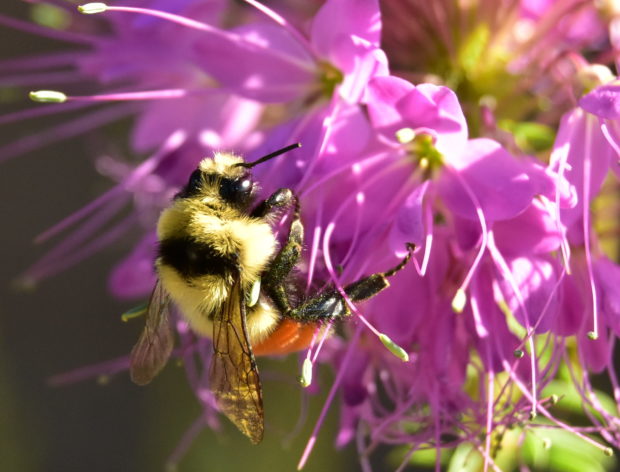We have much more to do and your continued support is needed now more than ever.
To Bee or Not to Bee: A Discussion on Honey Bees

We have grown up with honey bees following us around in gardens, apple orchards, and forests, easily identifiable by their honey yellow stripes and slim, hairy bodies, but what about the other bees out there?
Honey bees have long been known as the poster child for the “Save the Bees” campaigns, stealing much of the spotlight from native bees. The National Wildlife Federation’s sponsorship of “Rewilding Honeybees” at the International Wildlife Film Festival brought up many questions relating to “wild” bees. Were honey bees once wild? Where did honey bees originate from? How do honey bees and our native bees interact?

Honey bees are native to Europe and were first introduced to the United States in the 1600s for honey production. Now 400 years later, they are the most widely distributed livestock animal in the United States. We rely primarily on honey bees to pollinate 1/3 of the food we eat, making them paramount to commercial agriculture. Even though honey bees may be one of the most important species for humans, they compete heavily with native bee populations.
“While vital to agriculture and the economy, keeping honey bees is not wildlife conservation,” said National Wildlife Federation Naturalist David Mizejewski.
The Backbone of our Ecosystems
However, native bees are the backbone of our ecosystems. They are the ones who historically made our wildflowers grow big and strong. To determine whether a bee is considered native to an area, we look at the species’ geological span over time. Bee-lieve it or not there are about 4,000 native bee species in North America and 20,000 different species across the globe, according to Montana State University Extension.

The number of native bee species in Montana alone is estimated to be in the hundreds. National Wildlife Federation even has a poster of just Montana bumble bees, Genus Bombus, showcasing their variety of size, shape, and color. Native bees co-evolved to pollinate specific plants, making them instrumental to their ecosystems. Interestingly, some of these plants can only be pollinated by specific native pollinators, meaning honey bees’ pollination strategies are ill-suited, and some 30-60 percent of native bees can only feed on certain native plants without which they cannot survive.
Waiting in the Wings
Due to honey bees’ economic, agricultural, and recreational benefits, they have taken center stage in the bee world, leaving native bees in the wings (pun intended). Much of what we are taught is focused on honey bees, rather than all bees. For example, many of our bees are not black and yellow, rather blue or green. Mason bees are metallic green or blue and mining bees also may have a dull metallic blue or green body, but can also be black.
When we think of bees we typically associate them with colonies or as social bees, however, 90% of North America’s native bee species are solitary. Instead of living in hives, individual solitary bees nest in small tunnels in fallen logs, dead flower stalks, dead trees, or will build underground galleries. Unlike honey bees, solitary bees don’t have a queen or make honey. Without the need to protect a colony or queen, solitary bees are less likely to sting you (you’d really have to shake them up for them to sting).
While all this might leave you more confused, remember this; honey bees, or honey bee keeping, is important to supply our food sources. However, honey bees are still a domesticated species, just like chickens. The National Wildlife Federation is a wildlife advocacy and education organization that promotes native wildlife, including native birds and native bees, not backyard chickens and honey bee hives. We recognize by planting gardens for honey bees, native bees benefit too. The best way to benefit both honey bees and native bees is by planting native plants, some of which are pollinated more efficiently by native bees.
More bees are working than meets the eye, so next time you see a poster for “Save the Bees”, send a bee high five to all the native bees out there!





















